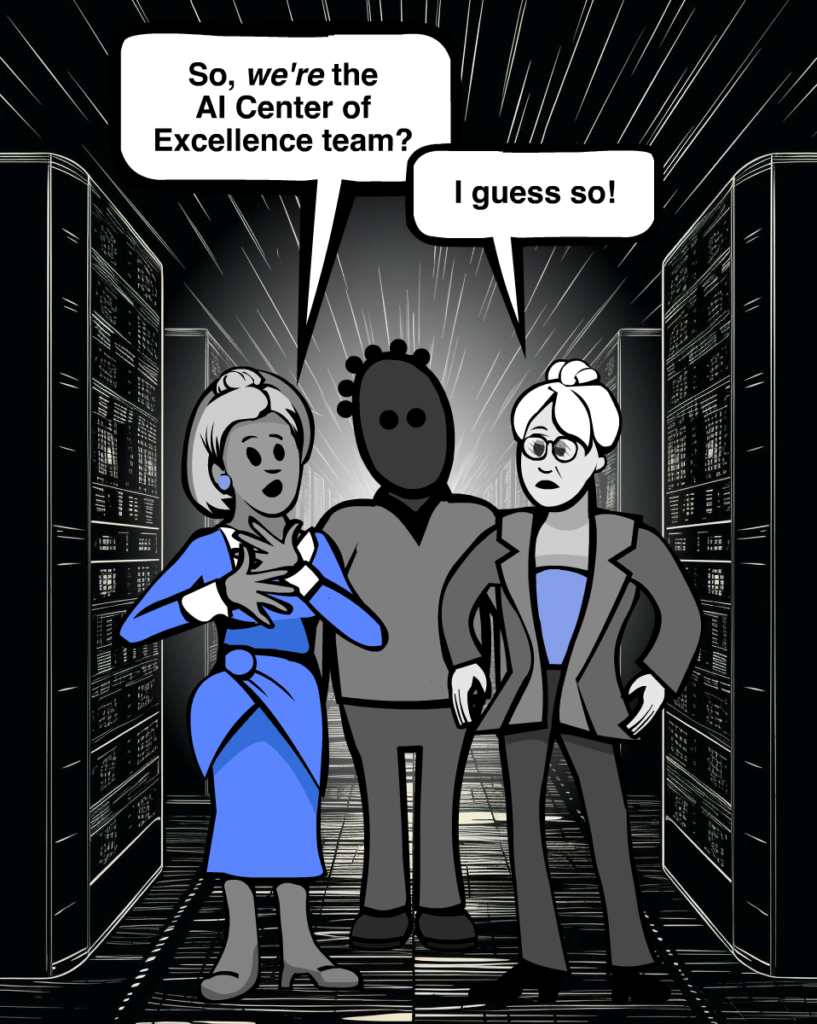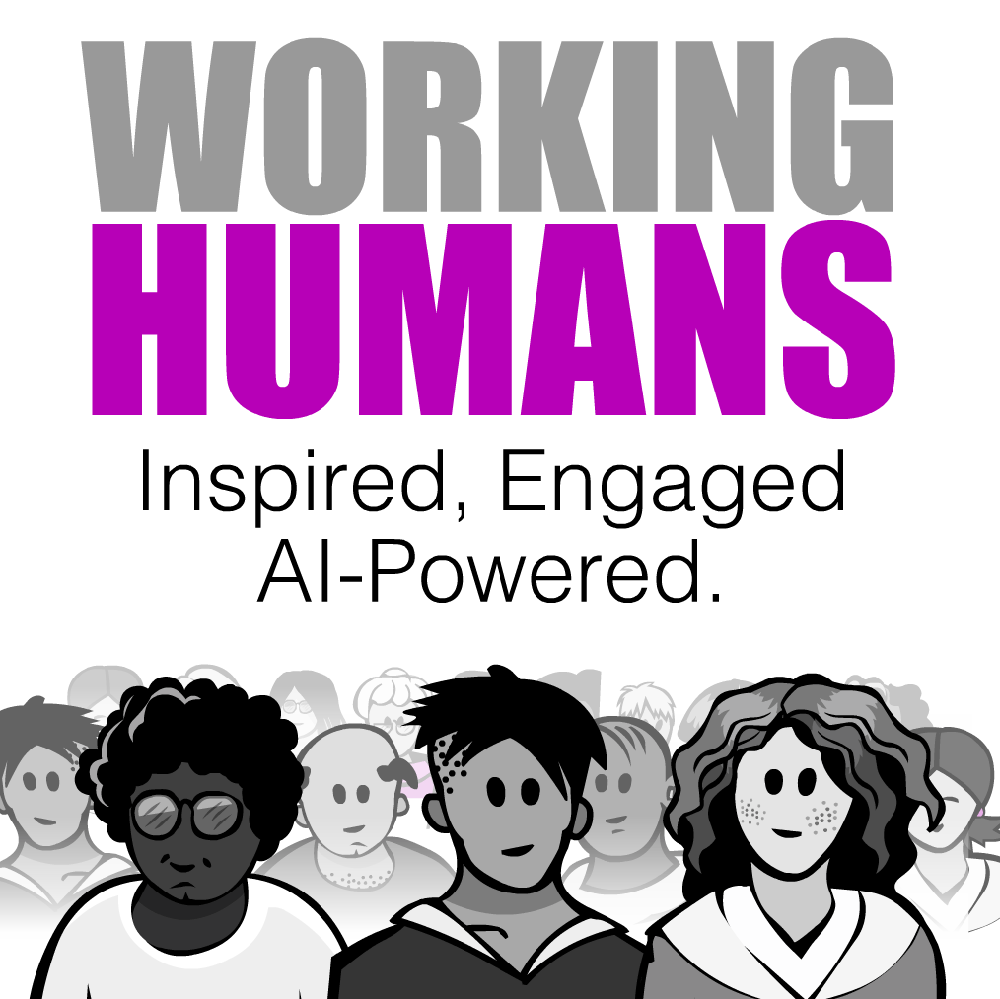AI-Powered Leadership
Fiona Passantino, late December 2023
The AI-powered leader wants a sustainable, continuously repeating AI maturity cycle within the organisation. A multidisciplinary AI Centre of Excellence (AI CoE) brings together expertise, best practices, and resources to drive excellence and innovation for the specific needs of the business. They start with the pain points – not “doing AI for the sake of doing AI” – and keep the learning and awareness loop levelling up for the organisation. Why an AI CoE is a good idea, and how to build one.
AI CoE
The field of AI is changing at lightning speed. We learn one system, one model or test drive one API for our business flow, and it feels like no sooner have we understood what it does and trained the team, another service is already offering something better, cheaper or with a new functionality
A good AI leader will necessarily want a sustainable, continuously repeating AI maturity cycle within the organisation. A small, multidisciplinary team is the best way to make sure this is done with the necessary energy, commitment and quality.
An AI Centre of Excellence (AI CoE) or an AI Competence Centre (AI CC) would bring together expertise, best practices, and resources to drive excellence and innovation in the area of AI for the specific needs of the business, starting with the most pressing pain points, ensuring that the learning and awareness loop keeps levelling up for the life cycle of the organisation.
This team can have a wide scope of responsibilities. It creates, validates and drives the AI vision, identifies use cases, conducts usability analysis, plans internal training and awareness events, manages external integration coaches, identifies and maintains internal AI champions within the company, keeps leadership informed and, importantly, shares success stories.
This is also the team that will liaise directly with external and internal AI developers when training and testing a model, connecting the needs of the business with suppliers and vendors, and making sure field teams are trained in its safe use once it’s up and running.
An AI CoE or AI CC is an idea that is neither new nor radical. About 37% of US-based companies using AI have already established a team like this, joining companies such as Deutsche Bank, J.P. Morgan Chase, Pfizer, Procter & Gamble, Anthem, and many others[i]. These are non-technical firms that are not necessary AI-first, but use AI to support back-end processes, customer-facing products or interfaces, and have created internal oversight groups to drive the conversation.

“The Crack AI CoE Team” Illustrated by Fiona Passantino
What does this team look like?
Multidiscipline is key. Starting with technical heavy-hitters that speak the language and understand what models need and use – data analysists and data engineers – since the company’s safe and effective use of data is one of the most important baseline conditions that make-or-break AI systems. This data may or may not be “ready for prime time”; with AI as with any analysis tool, how it works is utterly dependent upon the quality of the data that it’s fed. Can we use AI to clean and organise data? Sure; but doing this safely, internally and behind the firewall is no easy task and requires real structural competence.
At the other end of the table, equally important to a well-rounded AiCoE are expert communicators, employee engagement professionals, business representatives and client-facing professionals. There will need to be field-based professionals, working directly with the customers, whether on the retail floor or within the very logistics chain the organisation is planning to re-wire and upgrade.

Communicators and non-technical professionals are the ones who will keep data teams grounded and focused on the Human in the chain, whether that Human is a customer or an employee. They are also crucial for explaining the goals and track of the team for the non-technicals across the organisation.
What are the fundamentals of the AI roadmap, in its current iteration, and what are the expectations of all involved at any given time in its rollout? The communicator’s job is to not only understand the basics of AI, but explain it to stakeholders inside and outside the organisation, answering all the questions volleyed his way.
Some time each week will need to be devoted to this team’s education; scanning the horizon, staying up-to-date on developments at the intersection of AI and the industry, studying and experimenting with best practices before pulling a given AI solution into the organisation – or rather, recommending a solution and selling it up the chain.
The AI CoE coordinates internal training and development within the organisation. This may require pulling in external trainers and experts to offer running, repeating hybrid courses for employees at any level of the organisation, in several languages, as needed. This could be combined with weekly, open learning events for anyone wanting to join, where the team shares their knowledge about AI trends and practical, “how to” step-by-step guidance. Internal AI coaches are also identified, trained and coordinated by this team, ensuring that everyone has specialised support if they need it.
Governance is a key part of this teams’ responsibilities. There may already be siloed teams using AI, quietly, without informing anyone, opting to “ask for forgiveness, not permission”, if they are not in line with an understated AI governance policy. The AI CoE will need to find these teams and bring them in line with general organisational guidelines, and assign and AI coach to help them with their compliance. This is key to avoid duplication of efforts. It puts efficiency first, centralizing expertise and resources for all employees.
This team will need regular conferences with leadership to make sure there is a pipeline of resources, support, fast decision-making and follow-through. At the speed of AI evolution, a month’s delay can mean the difference between a timely deployment of a solution and that solution falling flat, already outdated and obsolete. If an organisation is chronically behind the competition, shipping improvements later and later due to onerous approval processes, it might be time to re-examine the landscape in which this team operates. To truly succeed in an AI business world, things need to move at a very different speed.

No eyeballs to read or watch? There’s a podcast for you!
- Listen to the APPLE PODCAST
- Listen to the SPOTIFY PODCAST
Search for the “Working Humans” podcast everywhere you like to listen. Twice a month, Fiona will dive into the nitty-gritty of employee engagement, communication, company culture and how AI is changing everything about how we work now and in the future. Subscribe so you never miss an episode. Rate, review and share.

About Fiona Passantino
Fiona is an AI Integration Specialist, coming at it from the Human approach; via Culture, Engagement and Communications. She is a frequent speaker, workshop facilitator and trainer.
Fiona helps leaders and teams engage, inspire and connect; empowered through our new technologies, to bring our best selves to work. She is a speaker, facilitator, trainer, executive coach, podcaster blogger, YouTuber and the author of the Comic Books for Executives series. Her next book, “AI-Powered”, is due for release soon.
[i] Davenport & Dasgupta (2023) “How to Set Up an AI Center of Excellence” Haravard Business Review. Accessed November 27, 2023. https://hbr.org/2019/01/how-to-set-up-an-ai-center-of-excellence

